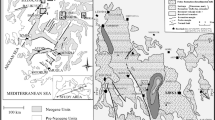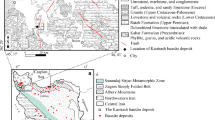Abstract
This study investigates the major and trace element geochemistry of Bigadi borate deposits, the largest colemanite and ulexite deposits in the world. The known borate deposits of Turkiye were deposited in the lacustrine environment during Miocene when the volcanic activity occurred from Tertiary to Quaternary. All of the Turkish borate deposits are classified as volcanic related deposits. Boron ore deposits intercalated with claystone, mudstone, tufa and fine layered limestone show lens shape. Borate minerals formed in two zones. Tiilu and Acep-Simav open mines represented the lower and upper borate zones, respectively. Colemanite and ulexite are dominant minerals at all ore zones. The major elements of Bigadi borates contain Ca, Si, Mg, Al, Fe, S, Na, P and Mn at Tiilu, Ca, Na, Si, Mg, S, Al, P and Mn at Simav, and Ca, Na, Si, Mg, S, AI and Mn at Acep samples respectively. Except for Li, Mo, Sb, As, Sr and Se, concentrations of other trace elements are significantly lower than averages of earth crust and andesite at the three mines. With respect to averages of earth crust and andesite, Mo, Sr, As, Li and particularly Se are enriched significantly in the Bigadi. In examining depth-dependent variations of major and trace elements, four element groups at the Tiilu site and six element groups at the Simav and Acep sites were determined. Element abudances or element geochemical trends show differences at the Tülü, Simav and Acep mines. These differences can be explained by the diversity of physicochemical conditions in the deposition environment by the effect of differences at the recharge regime and source.
Similar content being viewed by others
References
H. Meixner, “Some Borate Minerals from Turkiye (Colemanite and Tertschite, a New Mineral),” Fortschr. Mineral. 31, 39–42 (1952) (in German).
H. Meixner, “New Turkish Borate Deposits,” Berg. U. Hüttenmann. Monatsh. 98, 86–92 (1953) (in German).
H. Meixner, “New Borate Sitein İskeleköy, Bigadi Town, Balıkesir City,” Sonerabdruch aus Kaliund Steinsals, (Verlag Glöckauf, Essen, 1956) Vol. 2, pp. 43–47.
A. Helke, “Examination of Turkish Mineral Deposits II,” N. Jb. Min. Abh.: 178–180 (1955) (in German).
I. Özpeker and K. İnan, “Mineral Assemblages in Western Anatolian Borate Deposits and their Relations with Deposit Occurrence,” Bull. Geol. Soc. Turk. 21, 1–10 (1978) (in Turkish).
A. Kalafatoğlu, “Geology of the Region between Balıkesir and Kütahya,” Turk. Geol. Bull. 46–63 (1964) (in Turkish with English Abstract).
C. Helvacı, “Mineralogy of the Turkish Borate Deposits,” Geol. Eng. Bull. 17, 37–54 (1983).
C. Helvacı, “Stratigraphy, Mineralogy and Genesis of the Bigadi Borate Deposits, Western Turkiye,” Econ. Geol. 90, 1237–1260 (1995).
C. Helvacı and O. Alaca, “The Geology and Mineralogy of the Bigadi Borate Deposits,” Proceedings of 38th Turkish Geological Conress, 1984 (1984), pp. 110–111 (in Turkish).
C. Helvacı and O. Alaca, “Geology and Mineralogy of Bigadi Borate Deposits” MTA Bull. 113, 61–92 (1991) (in Turkish).
C. Helvacı and Ö Dora, “New Sights on Mineral Occurrences in the Bigadi Borate Deposits” Abstracts of 39th Turkish Geological Congress (1985), pp. 75–76 (in Turkish with English Abstract).
C. Helvacı and F. Orti, “Sedimantology and Diagenesis of Miocene Colemanite-Ulexite Deposits (Western Anatolia, Turkiye),” J. Sediment. Res. 68, 1021–1033 (1998).
C. Helvacı and R. N. Alonso, “Borate Deposits of Turkiye and Argentina: A Summary and Geological Comparison,” Turk. J. Earth Sci., No. 9, 1–27 (2000).
C. Helvaci, M. G. Stamatakis, C. Zagouroglou, and J. Kanaris, “Borate Minerals and Related Authigenic Silicates in Northeastern Mediterranean Late Miocene Continental Basins,” Explor. Min. Geol. 2, 171–178 (1993).
H. Helvacı, M. Mordoğan, M. Çolak, and İ. Gündoğan, “Presence and Distribution of Lithium in Borate Deposits and Some Recent Lake Waters of West-Central Turkiye,” Int. Geol. Rev. 46, 177–190 (2004).
C. Helvacı, “Turkish Borate Deposits,” Chamb. Geol. Eng. Publ., No. 71, (2001) (in Turkish).
C. Helvacı, “Turkish Borate Deposits: Their Geologic Setting, Economic Importance and Boron Policy,” Balıkesir Univ. Bull. 5.1, 4–41 (2003) (in Turkish).
C. Helvacı, “Turkish Borate Deposits: Their Geologic Setting, Economic Importance and Boron Policy,” in Proceedings of 5th Industrial Raw Materials Symposium, Izmir, Turkiye, 2004 (Izmir, 2004), pp. 11–27 (in Turkish).
C.J. Bowser, “Geochemistry and Petrology of the Sodium Borates in the Nonmarine Evaporite Environment,” (Univ. California, Los Angeles, 1964)
A. H. Christ, A. H. Truesdell and R.C. Erd, “Borate Mineral Assemblages in the System Na2O-CaO-MgO-B2O3-H2O,” Geochim. Cosmochim Acta 31, 313–339 (1967).
O. Bayasal and G. Ataman, “A New Borate Mineral in Turkiye: Discussion on Kernite Occurrence,” Turk. Geol. Surv. Bull. 18, 3–10 (1975) (in Turkish).
K. İnan, A Model for Formation of Hydrous Borate Minerals, Turk. Geol. Surv. Bull. 18, 165–168 (1975) (in Turkish).
M. Sunder, “Geochemistry of Sarıkaya (Kırka-Eski e-hir) Borate Deposits,” Turk. Geol. Surv. Bull. 2, 19–34 (1980).
K. B. Krauskopf, Introduction to Geochemistry, (McGraw-Hill International Editions, 1989).
E. Schroll, “Analytical Geochemistry” (Ferdinand Enke Verlag, Stuttgart, 1975) (in German).
O. Abollino, M. Aceto, S. Buoso, M. Gasparon, W. J. Green, M. Malandrino and E. Mentasti, “Distribution of Major, Minor and Trace Elements in Lake Environments of Antarctica,” Ant. Sci. 16(3), 227–291 (2004).
A. Şahinci, Geochemistry of Natural Waters (Reform Press, Izmir, 1991) (in Turkish).
Ş. Koç, İ Kavrazlı and İ. Koçak,“Geochemistry of Colemanite Deposit of Kestelek, Bursa, Turkiye,” in 33rd Intenational Geological Congress, Oslo, Norway, 2008 www.cprm.gov.br/33IGC/1352424.html) (2008).
V. M. Goldschmidt, Geochemistry Ed. by A. Muir (Clarendon Press, Oxford, 1954).
P. A. Rona, “Plate Tectonics and Mineral Resources” Sci. Amer. 229(1), 86–95 (1973).
O. Baysal, “Occurrence of Sarıkaya (Kırka) Borate Deposits,” in Turkish Mining Scientific and Technical Congress, Ankara, 1973 (Ankara, 1973), pp. 255–277.
E. M. Elkin and J. L. Margrave, “Selenium and Selenium Compounds” in Kirk Othmer Encyclopedia of Chemical Technology (New York, 1968), Vol. 17, pp. 809–833.
H. Halilova, “Biogeochemistry of Microelements (I, Zn, Co, Mn, Cu, Se),” (İlke-Eker Press, 2004) (in Turkish).
Y. Bürküt, “Distribution of Li, Rb, Cs and Sr in Ortho- and Para-gneiss and Some Petrologic Results” (Istanbul Technical University, Faculty of Mining, 1977) (in Turkish).
M. Akçay, “Geokimya” Karadeniz Technical University Publ., No. 204, Trabzon (2002) (in Turkish).
Author information
Authors and Affiliations
Corresponding author
Additional information
The article is published in the original.
Rights and permissions
About this article
Cite this article
Koçak, İ., Koç, Ş. Major and trace element geochemistry of the Bigadiç Borate deposit, Balikesir, Turkiye. Geochem. Int. 50, 926–951 (2012). https://doi.org/10.1134/S0016702912090030
Received:
Accepted:
Published:
Issue Date:
DOI: https://doi.org/10.1134/S0016702912090030




